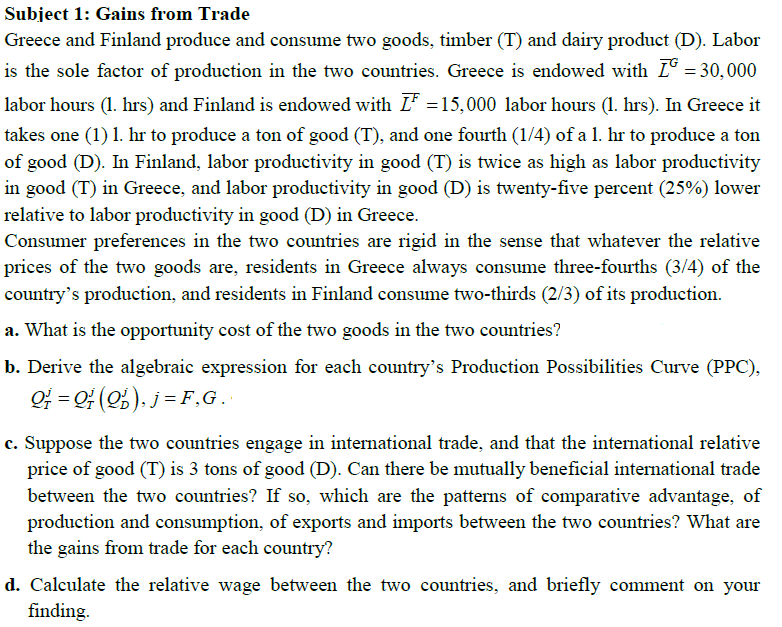Šubject 1: Gains from Trade Greece and Finland produce and consume two goods, timber (T) and dairy product (D). Labor is the sole factor of production in the two countries. Greece is endowed with Lº = 30,000 labor hours (1. hrs) and Finland is endowed with L =15,000 labor hours (1. hrs). In Greece it takes one (1) 1. hr to produce a ton of good (T), and one fourth (1/4) of a 1. hr to produce a ton of good (D). In Finland, labor productivity in good (T) is twice as high as labor productivity in good (T) in Greece, and labor productivity in good (D) is twenty-five percent (25%) lower relative to labor productivity in good (D) in Greece. Consumer preferences in the two countries are rigid in the sense that whatever the relative prices of the two goods are, residents in Greece always consume three-fourths (3/4) of the country's production, and residents in Finland consume two-thirds (2/3) of its production. a. What is the opportunity cost of the two goods in the two countries? b. Derive the algebraic expression for each country's Production Possibilities Curve (PPC), Of = Q (0%). j = F,G. c. Suppose the two countries engage in international trade, and that the international relative price of good (T) is 3 tons of good (D). Can there be mutually beneficial international trade between the two countries? If so, which are the patterns of comparative advantage, of production and consumption, of exports and imports between the two countries? What are the gains from trade for each country? d. Calculate the relative wage between the two countries, and briefly comment on your finding.
Šubject 1: Gains from Trade Greece and Finland produce and consume two goods, timber (T) and dairy product (D). Labor is the sole factor of production in the two countries. Greece is endowed with Lº = 30,000 labor hours (1. hrs) and Finland is endowed with L =15,000 labor hours (1. hrs). In Greece it takes one (1) 1. hr to produce a ton of good (T), and one fourth (1/4) of a 1. hr to produce a ton of good (D). In Finland, labor productivity in good (T) is twice as high as labor productivity in good (T) in Greece, and labor productivity in good (D) is twenty-five percent (25%) lower relative to labor productivity in good (D) in Greece. Consumer preferences in the two countries are rigid in the sense that whatever the relative prices of the two goods are, residents in Greece always consume three-fourths (3/4) of the country's production, and residents in Finland consume two-thirds (2/3) of its production. a. What is the opportunity cost of the two goods in the two countries? b. Derive the algebraic expression for each country's Production Possibilities Curve (PPC), Of = Q (0%). j = F,G. c. Suppose the two countries engage in international trade, and that the international relative price of good (T) is 3 tons of good (D). Can there be mutually beneficial international trade between the two countries? If so, which are the patterns of comparative advantage, of production and consumption, of exports and imports between the two countries? What are the gains from trade for each country? d. Calculate the relative wage between the two countries, and briefly comment on your finding.
Linear Algebra: A Modern Introduction
4th Edition
ISBN:9781285463247
Author:David Poole
Publisher:David Poole
Chapter2: Systems Of Linear Equations
Section2.4: Applications
Problem 28EQ
Related questions
Question

Transcribed Image Text:Subject 1: Gains from Trade
Greece and Finland produce and consume two goods, timber (T) and dairy product (D). Labor
is the sole factor of production in the two countries. Greece is endowed with L = 30,000
labor hours (1. hrs) and Finland is endowed with I =15,000 labor hours (1. hrs). In Greece it
takes one (1) 1. hr to produce a ton of good (T), and one fourth (1/4) of a 1. hr to produce a ton
of good (D). In Finland, labor productivity in good (T) is twice as high as labor productivity
in good (T) in Greece, and labor productivity in good (D) is twenty-five percent (25%) lower
relative to labor productivity in good (D) in Greece.
Consumer preferences in the two countries are rigid in the sense that whatever the relative
prices of the two goods are, residents in Greece always consume three-fourths (3/4) of the
country's production, and residents in Finland consume two-thirds (2/3) of its production.
a. What is the opportunity cost of the two goods in the two countries?
b. Derive the algebraic expression for each country's Production Possibilities Curve (PPC),
OF = Q (2). j = F,G.
c. Suppose the two countries engage in international trade, and that the international relative
price of good (T) is 3 tons of good (D). Can there be mutually beneficial international trade
between the two countries? If so, which are the patterns of comparative advantage, of
production and consumption, of exports and imports between the two countries? What are
the gains from trade for each country?
d. Calculate the relative wage between the two countries, and briefly comment on your
finding.
Expert Solution
This question has been solved!
Explore an expertly crafted, step-by-step solution for a thorough understanding of key concepts.
Step by step
Solved in 2 steps

Recommended textbooks for you

Linear Algebra: A Modern Introduction
Algebra
ISBN:
9781285463247
Author:
David Poole
Publisher:
Cengage Learning

Algebra & Trigonometry with Analytic Geometry
Algebra
ISBN:
9781133382119
Author:
Swokowski
Publisher:
Cengage

Linear Algebra: A Modern Introduction
Algebra
ISBN:
9781285463247
Author:
David Poole
Publisher:
Cengage Learning

Algebra & Trigonometry with Analytic Geometry
Algebra
ISBN:
9781133382119
Author:
Swokowski
Publisher:
Cengage